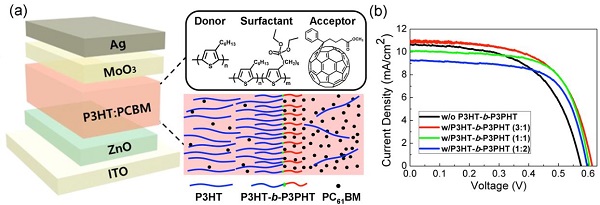 +565 975 658
+565 975 658
 info@premiumcoding.com
info@premiumcoding.com
 Monday - Friday, 8.00 - 20.00
Monday - Friday, 8.00 - 20.00
Organic photovoltaics (OPVs) have drawn an extensive amount of attention due to the features of low cost, light weight, flexibility and ease of manufacturing with solution processes. However, there are still two key issues to be solved for future practical applications: increase power conversion efficiency (PCE) and long-term stability. Uncontrollable macrophase separation between donors and acceptors occurs after long operating time or continuous thermal annealing, resulting in decreased PCE and lifetime dramatically.
Recently, Prof. Juan Peng and coworkers designed a series of all-conjugated diblock copolymers, poly(3-hexylthiophene)-b-poly(3-(6-diethylphosphonatohexyl) thiophene) (P3HT-b-P3PHT), and used them as additives to improve the performance of P3HT:PC61BM-based photovoltaic devices. Usually, the increased PCE are attributed to an improvement in Jsc or Voc by carefully designing organic photovoltaic materials. In this work, the significant increase in the PCE was mainly due to the improvement in fill factor (FF). The P3HT-b-P3PHT diffused at the P3HT:PC61BM interface, improved the miscibility between them, optimized the nanoscale morphology of the photoactive layer, and reduced the active layer roughness, which enlarged the donor/acceptor interfacial areas, thus reduced the charge recombination rate. The research provides a possible strategy toward high efficiency organic photovoltaic devices with enhanced thermal stability.
This work was collaborated with Prof. Dong Ha Kim in Ewha Womans University. Mingjing Zhu and Heejun Kim are the first authors. This work was published on J. Mater. Chem. A. See details: Mingjing Zhu, Heejun Kim, Yu Jin Jang, Sungmin Park, Du Yeol Ryu, Kyungkon Kim, Ping Tang, Feng Qiu, Dong Ha Kim,* and Juan Peng*, J. Mater. Chem. A, 2016, DOI:10.1039/C6TA08181A.
Article links:http://pubs.rsc.org/en/content/articlelanding/2016/ta/c6ta08181a#!divAbstract

Get to know us better now!

Wechat:FDUMMers
Search!
Search across our website
Revenant @ 2018 by fudan | All Rights Reserved
Powered by Weicheng

